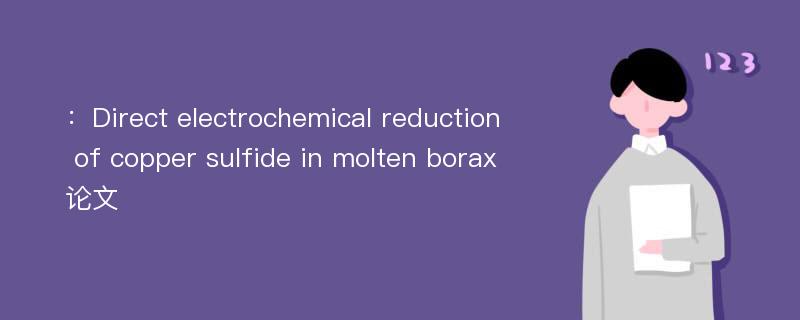
本文主要研究内容
作者(2019)在《Direct electrochemical reduction of copper sulfide in molten borax》一文中研究指出:In this study, for the first time, direct copper production from copper sulfide was carried out via direct electrochemical reduction method using inexpensive and stable molten borax electrolyte.The effects of current density(100–800 mA/cm~2) and electrolysis time(15–90 min) on both the cathodic current efficiency and copper yield were systematically investigated in consideration of possible electrochemical/chemical reactions at 1200℃.The copper production yield reached 98.09% after 90 min of electrolysis at a current density of 600 mA/cm~2.Direct metal production was shown to be possible with 6 kWh/kg energy consumption at a 600 mA/cm~2 current density, at which the highest current efficiency(41%) was obtained.The suggested method can also be applied to metal/alloy production from single-and mixed-metal sulfides coming from primary production and precipitated sulfides, which are produced in the mining and metallurgical industries during treatment of process solutions or wastewaters.
Abstract
In this study, for the first time, direct copper production from copper sulfide was carried out via direct electrochemical reduction method using inexpensive and stable molten borax electrolyte.The effects of current density(100–800 mA/cm~2) and electrolysis time(15–90 min) on both the cathodic current efficiency and copper yield were systematically investigated in consideration of possible electrochemical/chemical reactions at 1200℃.The copper production yield reached 98.09% after 90 min of electrolysis at a current density of 600 mA/cm~2.Direct metal production was shown to be possible with 6 kWh/kg energy consumption at a 600 mA/cm~2 current density, at which the highest current efficiency(41%) was obtained.The suggested method can also be applied to metal/alloy production from single-and mixed-metal sulfides coming from primary production and precipitated sulfides, which are produced in the mining and metallurgical industries during treatment of process solutions or wastewaters.
论文参考文献
[1].Liquidus Temperatures of System Na3AlF6-K3AlF6-AlF3 for Aluminum Electrolysis at Lower Temperature[J]. WEI Chen-juan, LAI Yan-qing, LI Jie*, TIAN Zhong-liang, WANG Jia-wei, ZOU Zhong and LIU Ye-xiang School of Metallurgical Science and Engineering, Central South University, Changsha 410083, P. R. China. Chemical Research in Chinese Universities.2011(06)[2].Electrical Conductivity and Corrosion Resistanceof ZnFe2O4Based Materials Used as Inert Anodefor Aluminum Electrolysis[J]. YU Xian jin ZHANG Guang li * QIU Zhu xian * ZHAO Min shou SU Qiang (Changchun Institute of Applied Chemistry, Chinese Academy of Science; *Northeast University). Journal of Shanghai University.1999(03)[3].Electrochemical Preparation of V2O3 from NaVO3 and Its Reduction Mechanism[J]. 翁威,王明涌,GONG Xuzhong,WANG Zhi,WANG Dong,GUO Zhancheng. Journal of Wuhan University of Technology(Materials Science).2017(05)[4].Structural parameter optimization for novel internal-loop iron–carbon micro-electrolysis reactors using computational fluid dynamics[J]. Lei Zhang,Mengyu Wu,Yanhe Han,Meili Liu,Junfeng Niu. Chinese Journal of Chemical Engineering.2019(04)[5].Optimization of electrocatalytic properties of NiMoCo foam electrode for water electrolysis by post-treatment processing[J]. Jian-Wei Wang,Yue-Fa Wang,Jing-Guo Zhang,Yan-Lin Yu,Ge-Ge Zhou,Lei Cheng,Lin-Shan Wang,Z.Zak Fang. Rare Metals.2015(11)[6].In-situ electrochemical activation designed hybrid electrocatalysts for water electrolysis[J]. Xiao Shang,Bin Dong,Yong-Ming Chai,Chen-Guang Liu. Science Bulletin.2018(13)[7].A perspective on hydrogen production via high temperature steam electrolysis[J]. Xinbing Chen,Chengzhi Guan,Guoping Xiao,Cheng Peng,Jian-Qiang Wang. Science China(Chemistry).2017(11)[8].Preparation of La2O3 by ion-exchange membrane electrolysis of LaCl3 aqueous solution[J]. Deliang Meng,Qiuyue Zhao,Xijuan Pan,Ting’an Zhang. Journal of Rare Earths.2019(09)[9].Advance in highly efficient hydrogen production by high temperature steam electrolysis[J]. YU Bo1, ZHANG WenQiang1, CHEN Jing1, XU JingMing1 & WANG ShaoRong2 1 Institute of Nuclear and New Energy Technology, Tsinghua University, Beijing 102201, China; 2 Shanghai Institute of Ceramics, Chinese Academy of Sciences, Shanghai 200050, China. Science in China(Series B:Chemistry).2008(04)[10].Advances in electrocatalysts for oxygen evolution reaction of water electrolysis-from metal oxides to carbon nanotubes[J]. Yi Cheng,San Ping Jiang. Progress in Natural Science:Materials International.2015(06)
论文详细介绍
论文作者分别是来自International Journal of Minerals Metallurgy and Materials的,发表于刊物International Journal of Minerals Metallurgy and Materials2019年08期论文,是一篇关于,International Journal of Minerals Metallurgy and Materials2019年08期论文的文章。本文可供学术参考使用,各位学者可以免费参考阅读下载,文章观点不代表本站观点,资料来自International Journal of Minerals Metallurgy and Materials2019年08期论文网站,若本站收录的文献无意侵犯了您的著作版权,请联系我们删除。
标签:International Journal of Minerals Metallurgy and Materials2019年08期论文;
:Direct electrochemical reduction of copper sulfide in molten borax论文
下载Doc文档
